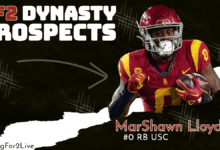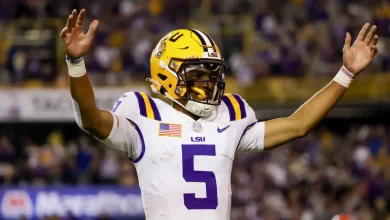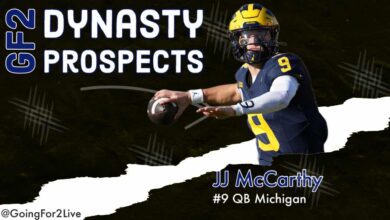
Stacking, in daily fantasy sports is simply using two or more players, who share a symbiotic on field relationship, from the same team. A good stack can really give a DFS player a nice edge in contests and can “multiply” fantasy points, while a bad stack can be a death train, ruining any chance a line-up has to cash in contests. In this article we’ll examine some of the most common stacks, why they work and why they can be dangerous, and how to effectively use stacks.
QUARTERBACK – WIDE RECEIVER/TIGHT END STACK
By far, this is the most common stack used in daily fantasy sports. The theory behind this stack is that every time the QB completes a pass to the receiver, points are “multiplied.” For example, let’s say you have a stack of Aaron Rogers and Jordy Nelson and Rogers completes a 40 yard TD pass to Nelson. On Fan Duel you would get 5.6 points from Rogers (1.6 points for the 40 yards and 4 for the passing TD) and 10 Nelson (4 points for the 40 yards and 6 points for the receiving TD.) This can be a very effective strategy in guaranteed prize pool tournaments (GPPs) in which you need a lot of points to cash out.
While this stack can lead to a lot of fantasy points if the QB and receiver both have good games, it can kill your line up if the QB has a bad game. For this reason, unless a QB and WR/TE both have outstanding match-ups, I tend to avoid it in cash games (double-ups, 50/50s and head to head contests.) In cash games you don’t have to have the most points to win money, you simply have to beat about 50% of the field, so a more conservative approach is taken. I’ve used this stack successfully in cash games, and I would never pretend to tell anyone to never stack in cash games, but the match-ups have to be perfect.

Some successful DFS players have this stack in nearly every GPP line up and claim it’s the only path to winning these contests. I honestly don’t believe this to be the case. For example you can use Andrew Luck in a GPP and not roster any of his receivers, since the Colts will have 4 effective WRs and 2 TEs this season. Picking one to pair with Luck could hurt your line up if that receiver isn’t the guy Luck is targeting that particular week.
QUARTERBACK – 2 WIDE RECEIVER/ WIDE RECEIVER + TIGHT END STACK
Essentially, this stack involves using a QB with two of his receivers, 2 WRs or a WR and a TE.. To begin, this stack is fraught with peril and should be used in GPPs only and never in cash games. On 30 November 2014, if you’d have had Ryan Fitzpatrick (24/33-358-6), DeAndre Hopkins (9-238-3) and Andre Johnson (7-53-1) you would have made a lot of money. Also, on 26 October 2014, had you rostered Ben Roethlisberger (40/49-522-6), Antonio Brown (10-133-2) and Martavis Bryant (5-83-2) you would have cashed big.
The problem here is that these results are few and far between. This stack is a long shot bet that rarely pays off, but when it does pay off, it pays off big. This is the DFS equivalent of betting a 50-1 shot at the track. As I mentioned earlier, this stack should only be used in tournaments and only when the match-up dictates. For the record, I’ve only used this stack in a small handful of line-ups and never successfully.
QUARTERBACK – RUNNING BACK
In the vast majority of cases, this stack dooms your line-up for failure, since by definition QBs and RBs on the same team are “competing” for fantasy points. The only time this stack works is when you have good match-ups for both positions and the RB is an elite receiver. An example of this situation is Jay Cutler and Matt Forte of the Bears. Forte was targeted an amazing 130 times last season while compiling a 102-808-4 line as a receiver. Those are good WR numbers.
The above mentioned situation is the exception, not the rule. Generally speaking, unless you’re playing on a short slate of games (4PM, Monday – Thursday, etc.), stacking a QB with his RB is a very bad idea in DFS.
RUNNING BACK – DEFENSE
Love our content? Check out the GoingFor2 Live Podcast Network!
The rationale behind this stack is simple. If the defense has a good game the team is usually in the lead and if the team is in the lead, they’ll run the ball more to kill the clock. In theory this makes sense, but I’ve never designed a line-up around this sort of stack. I have had line-ups with this stack in them (based solely on match-ups) that have cashed out.
I tend to use match-ups and the Vegas odds to select my running backs and defenses, so when I’ve used this stack, it’s been more accidental than deliberately looking to do it. Still the theory behind using this makes a lot of sense, so this season I may be looking into using this stack a bit more, particularly in games Vegas views as potential blowouts.
All of these stacks can be used to successfully bolster your line ups. You can even get creative and use a QB/WR stack along with a RB/Defense stack in the same GPP line-up. You have to be careful though, not to force stacks in your line-ups. Always go for the best value with the best match-ups, but when the situation presents itself, stack are a powerful way to get more bang for your buck.
ATTN Dynasty Commissioners: Do you want to do something cool for your league? How about a 1-hour live show dedicated to YOUR league? Team-by-team breakdowns, rankings, and more. For details and to book a show, visit: GoingFor2.com/plp.






